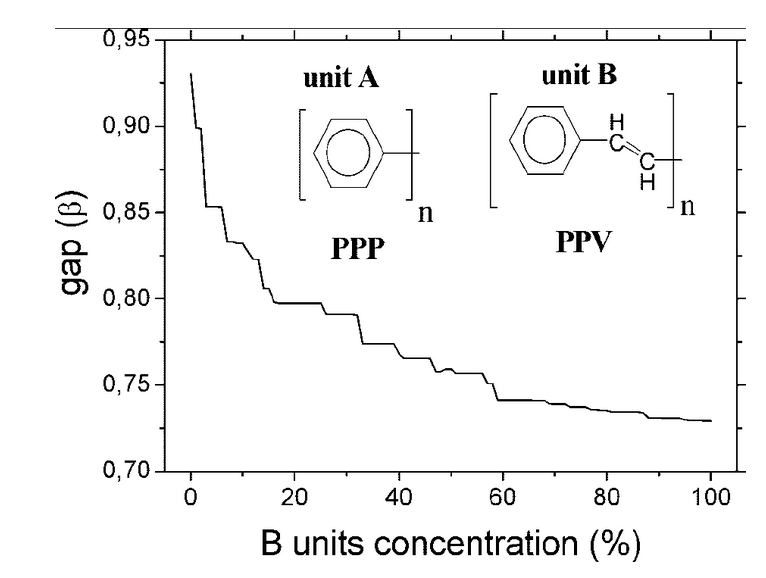1.
Giro, Ronaldo; Caldas, Mar'ilia Junqueira; Galvao, Douglas Soares
Band gap engineering for poly (p-phenylene) and poly (p-phenylene vinylene) copolymers using the tight-binding approach Journal Article
In: International Journal of Quantum Chemistry, vol. 103, no. 5, pp. 588–596, 2005.
@article{giro2005band,
title = {Band gap engineering for poly (p-phenylene) and poly (p-phenylene vinylene) copolymers using the tight-binding approach},
author = {Giro, Ronaldo and Caldas, Mar'ilia Junqueira and Galvao, Douglas Soares},
url = {http://onlinelibrary.wiley.com/doi/10.1002/qua.20551/full},
year = {2005},
date = {2005-01-01},
journal = {International Journal of Quantum Chemistry},
volume = {103},
number = {5},
pages = {588--596},
publisher = {Wiley Online Library},
abstract = {The interest in poly(p-phenylene) (PPP) and poly(p-phenylene vinylene) (PPV) copolymers stems from the fact that these homopolymers present interesting optical and electronic properties that allow a great variety of technological applications. Combining different numbers of PPP and PPV units it is possible, in principle, to obtain new structures presenting intermediate gap values (2.8 eV and 2.4 eV for PPP and PPV, respectively). For this study we used a Hückel Hamiltonian tight-binding coupled to the negative factor counting (NFC) technique. We carried out a systematic search to determine optimum relative concentrations for disordered binary polymeric alloys with predefined gap values. Once these structures were obtained, we used the semiempirical methods AM1/PM3 and ZINDO/S-CI for geometrical and optical studies, respectively. Our theoretical results show that it is possible to obtain copolymers of PPP and PPV with intermediate gap values of their parent structures. © 2005 Wiley Periodicals, Inc. Int J Quantum Chem, 2005},
keywords = {},
pubstate = {published},
tppubtype = {article}
}
The interest in poly(p-phenylene) (PPP) and poly(p-phenylene vinylene) (PPV) copolymers stems from the fact that these homopolymers present interesting optical and electronic properties that allow a great variety of technological applications. Combining different numbers of PPP and PPV units it is possible, in principle, to obtain new structures presenting intermediate gap values (2.8 eV and 2.4 eV for PPP and PPV, respectively). For this study we used a Hückel Hamiltonian tight-binding coupled to the negative factor counting (NFC) technique. We carried out a systematic search to determine optimum relative concentrations for disordered binary polymeric alloys with predefined gap values. Once these structures were obtained, we used the semiempirical methods AM1/PM3 and ZINDO/S-CI for geometrical and optical studies, respectively. Our theoretical results show that it is possible to obtain copolymers of PPP and PPV with intermediate gap values of their parent structures. © 2005 Wiley Periodicals, Inc. Int J Quantum Chem, 2005
2005
1.

Giro, Ronaldo; Caldas, Mar'ilia Junqueira; Galvao, Douglas Soares
Band gap engineering for poly (p-phenylene) and poly (p-phenylene vinylene) copolymers using the tight-binding approach Journal Article
In: International Journal of Quantum Chemistry, vol. 103, no. 5, pp. 588–596, 2005.
Abstract | Links | BibTeX | Tags: Conducting Polymers, Electronic Structure, PPP, PPV
@article{giro2005band,
title = {Band gap engineering for poly (p-phenylene) and poly (p-phenylene vinylene) copolymers using the tight-binding approach},
author = {Giro, Ronaldo and Caldas, Mar'ilia Junqueira and Galvao, Douglas Soares},
url = {http://onlinelibrary.wiley.com/doi/10.1002/qua.20551/full},
year = {2005},
date = {2005-01-01},
journal = {International Journal of Quantum Chemistry},
volume = {103},
number = {5},
pages = {588--596},
publisher = {Wiley Online Library},
abstract = {The interest in poly(p-phenylene) (PPP) and poly(p-phenylene vinylene) (PPV) copolymers stems from the fact that these homopolymers present interesting optical and electronic properties that allow a great variety of technological applications. Combining different numbers of PPP and PPV units it is possible, in principle, to obtain new structures presenting intermediate gap values (2.8 eV and 2.4 eV for PPP and PPV, respectively). For this study we used a Hückel Hamiltonian tight-binding coupled to the negative factor counting (NFC) technique. We carried out a systematic search to determine optimum relative concentrations for disordered binary polymeric alloys with predefined gap values. Once these structures were obtained, we used the semiempirical methods AM1/PM3 and ZINDO/S-CI for geometrical and optical studies, respectively. Our theoretical results show that it is possible to obtain copolymers of PPP and PPV with intermediate gap values of their parent structures. © 2005 Wiley Periodicals, Inc. Int J Quantum Chem, 2005},
keywords = {Conducting Polymers, Electronic Structure, PPP, PPV},
pubstate = {published},
tppubtype = {article}
}
The interest in poly(p-phenylene) (PPP) and poly(p-phenylene vinylene) (PPV) copolymers stems from the fact that these homopolymers present interesting optical and electronic properties that allow a great variety of technological applications. Combining different numbers of PPP and PPV units it is possible, in principle, to obtain new structures presenting intermediate gap values (2.8 eV and 2.4 eV for PPP and PPV, respectively). For this study we used a Hückel Hamiltonian tight-binding coupled to the negative factor counting (NFC) technique. We carried out a systematic search to determine optimum relative concentrations for disordered binary polymeric alloys with predefined gap values. Once these structures were obtained, we used the semiempirical methods AM1/PM3 and ZINDO/S-CI for geometrical and optical studies, respectively. Our theoretical results show that it is possible to obtain copolymers of PPP and PPV with intermediate gap values of their parent structures. © 2005 Wiley Periodicals, Inc. Int J Quantum Chem, 2005
http://scholar.google.com/citations?hl=en&user=95SvbM8AAAAJ


